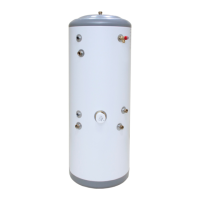Page 22 Section 6: Commissioning, Draining Down and Safety
6.8 BALANCING THE PRIMARY CIRCUIT
With the cylinder installed as described in Sections 3, 4 and 5
of these instructions, the primary heating appliance installed
according to the manufacturer’s instructions, the primary circuit
lled and vented as per the heating appliance manufacturer’s
instructions and the cylinder lled with water (refer to Section 6.1);
the circuit can be balanced.
To balance the primary circuit:
1. Access the automatic system bypass that is supplied factory
tted to the cylinder by following the procedure outlined in
Section 3.6.1.
2. Fully open all TRVs tted to radiators on the system.
• In warmer climates it may be necessary to slacken
the TRV heads o, in order to prevent the ambient
temperature closing the TRVs down.
3. Ensure the automatic bypass valve is fully closed. The valve
is closed by rotating it clockwise (viewed from beneath
valve).
4. Set any circulating pumps tted to the system to their
optimum setting, as per the pump manufacturer’s
instructions.
• If a Grant Aerona³ heat pump is tted, initially set
the circulating pump contained in the unit to level 1
(minimum). Refer to the installation instructions supplied
with the Aerona³ heat pump.
• If the system requires, increase the pump speed to level
2 or even level 3.
5. Turn the heating appliance on, operate the system in space
heating mode and allow the system to start heating up.
6. With the system ow temperature approaching its set value,
check the temperature dierence between the ow and return
pipes connected to each heat emitter on the system, starting
with the emitter closest to the heating appliance.
• In the case of a Grant Aerona³ heat pump, this
temperature dierence should be approximately 6 to
8°C.
• For other heating appliances, refer to the manufacturer’s
instructions.
7. In instances where this temperature dierence is too low,
close the appropriate radiator lockshield valve fully and open
no more than half a turn. Repeat this process for the next
radiator in the circuit until the desired ow/return temperature
dierence has been achieved for all heat emitters on the
system.
! NOTE !
Throughout the process of balancing the system, it
is important to ensure that the heating appliance is
continuously operating to provide heat to the space
heating circuit.
8. Turn the heating appliance o and allow the system to cool.
9. While the system is cooling and with the automatic bypass
valve still fully closed, tighten any TRV heads that were
slackened and fully close all TRVs on the system.
10. With all TRVs on the system fully closed, turn the heating
appliance on and operate the system in space heating mode.
Allow the system to reach operating temperature.
11. Open the automatic bypass valve until you detect that water
is just starting to ow through it. The valve is opened by
rotating it anti-clockwise (viewed from beneath valve).
12. Ensure the heating appliance is operating at the chosen ow
temperature without either modulating down (in the case of a
modulating appliance) or switching o (in the case of a xed
output appliance).
If the appliance is either modulating down or switching o,
open the automatic bypass valve slightly until a situation
is achieved where all TRVs on the system are fully closed
and the appliance continues to run at the chosen operating
temperature.
13. Leave the automatic bypass valve in this position, open
all TRVs fully and allow the system to run according to the
householder’s requirements.
The primary circuit has now been balanced and the automatic
bypass valve has been set.
6.9 CUSTOMER HANDOVER
1. Complete the commissioning and service log at the back of
these instructions and leave the instructions with the user.
2. Explain the operation of the system to the User, referring to
Section 12 of these instructions.
3. In particular, make the user aware of what to do if water is
seen to ow from either the T&P Valve or Expansion relief
Valve.
4. Refer the user to the Information given in Section 12 of these
instructions.
! NOTE !
Leave these Installation, Servicing and User instructions
with the user for future reference.

